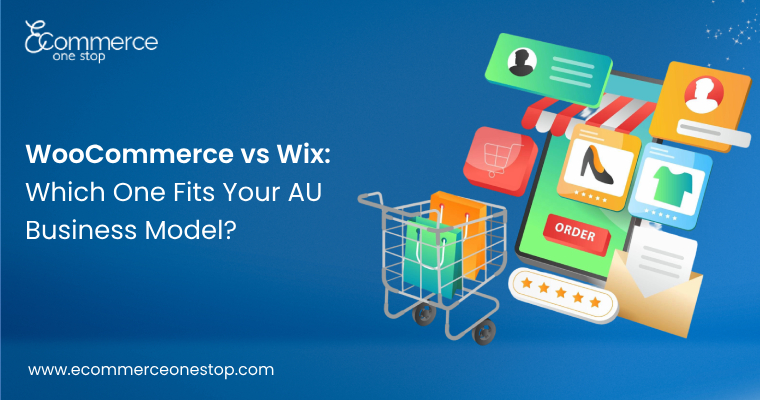With the e-commerce market in Australia set to hit US$42.04 billion by 2025, businesses are increasingly turning to online platforms to capitalize on this growth (
Statista). Two popular options stand out: WooCommerce and Wix. Both platforms offer unique features and benefits, but choosing the right one for your Australian business model can make all the difference.
In this blog, we’ll explore WooCommerce and Wix in depth, comparing their features, costs, scalability, and more, to help you make an informed decision. Whether you’re considering
custom WooCommerce development services or
Wix ecommerce development, this guide will help you understand which platform aligns best with your needs.
Get Your Project Started
Book a free consultation with our Ecommerce experts.
Connect Now

Overview of WooCommerce
WooCommerce is a free, open-source e-commerce plugin for WordPress that transforms your website into a fully functional online store. It’s renowned for its flexibility and customization options, making it a top choice for businesses that want full control over their online presence.
Key Features of WooCommerce
- Customization: With thousands of themes and extensions, you can design your store exactly as you envision it. From basic design elements like colors and fonts to advanced functionalities, WooCommerce offers endless possibilities.
- Product & Catalog Management: Sell any type of product, including physical goods, digital downloads, and services. Manage product variations, set up categories and tags, and enable customer reviews to build trust.
- Order & Inventory Management: Keep track of stock levels, set up low stock alerts, and manage backorders. The platform also allows you to mark orders as shipped and provides a multi-site dashboard for overseeing multiple stores.
- SEO & Marketing: Leverage WordPress’s SEO capabilities with plugins like Yoast SEO. WooCommerce also offers built-in marketing tools such as email automation for review requests and wishlist reminders, as well as coupon creation for promotions.
- Multichannel Selling: Expand your reach by selling on multiple platforms like Amazon, Etsy, and social media shops. Plugins like LitCommerce make it easy to sync products and inventory across channels.
- Payment Gateways: Accept payments through a wide range of gateways, including Stripe, PayPal, and local options. Over 80 payment extensions are available in the WooCommerce Extension Store.
- Shipping Methods: Choose from default shipping options like flat rate and free shipping, or integrate with major carriers for live rates. Set up shipping zones and classes for more precise control.
- Checkout Setup: Offer guest checkout, encourage account creation, and optimize the checkout process with extensions like WooCommerce One-Page Checkout for a smoother experience.
- Refund Processing: Handle refunds automatically or manually, with logs kept in the order history. The process depends on the policies of your chosen payment gateway.
- Analytics & Reports: Gain insights into your store’s performance with metrics like total sales, order growth, best-selling products, and average order value. Integrate with Google Analytics for more detailed data.
- Mobile App Version: Manage your store on-the-go with the WooCommerce mobile app, which allows you to add products, fulfill orders, and track metrics in real-time.
WooCommerce is ideal for businesses that value flexibility and are willing to invest time in setup and customization. For those needing tailored solutions, custom WooCommerce development services can further enhance the platform’s capabilities.
Overview of Wix
Wix is a cloud-based web development platform that provides a simple, drag-and-drop website builder with integrated e-commerce tools. It’s designed for users who want to create a professional website without any coding knowledge.
Key Features of Wix
- Wix eCommerce: A comprehensive solution for online retailers, enabling global business management with features like product listings, inventory management, and order processing.
- Wix Editor: A user-friendly drag-and-drop editor that comes with over 500 templates to choose from, making it easy to design a visually appealing store.
- Wix ADI: An AI-based tool that creates a website in minutes by asking you questions about your brand and preferences, perfect for those who want a quick setup.
- Velo by Wix: For advanced users, Velo offers an open development platform with 100+ UI elements and serverless computing, allowing for front-end innovation and customization.
- Wix Bookings: A 24/7 booking system that lets you manage appointments, accept online payments, and sync with Google Calendar. It’s great for service-based businesses.
- Wix Blog: An easy-to-use blogging tool with customizable templates, helping you engage with your audience and improve SEO.
- Wix Media: Tools for adding music, photography, and video to your site, enhancing your brand’s identity. Be mindful of file sizes and copyrights.
- Wix Events:Design invitation emails, track RSVPs, and sell tickets for events, which can boost sales during special occasions.
- Wix Restaurants: Specifically for food and beverage brands, offering custom menus, online ordering, and reservation systems.
- Marketing & SEO: Advanced SEO tools, setup checklists, email marketing integration with Mailchimp, and Wix Referral Platforms to encourage word-of-mouth marketing.
- Newest Features (2025): Afterpay for US orders (with potential expansion), Adobe Express for image editing, and new payment gateways like Google Pay, Tap to Pay, and Moneris.
Wix is perfect for small to medium-sized businesses that want an all-in-one solution without the need for extensive technical expertise. For those looking to enhance their Wix store, hiring a Wix web developer can provide custom solutions using tools like Velo by Wix.
Comparison: WooCommerce vs Wix
Let’s compare WooCommerce and Wix based on several key factors to help you decide which platform best suits your AU business model.
1. Ease of Use
- WooCommerce: Requires knowledge of WordPress for setup and management. While there are many tutorials and support resources available, it can be challenging for beginners. Custom WooCommerce development services can help alleviate some of these challenges.
- Wix: Extremely user-friendly with its drag-and-drop interface. Even users with no technical background can create a professional-looking store quickly.
2. Customization
- WooCommerce: Offers unparalleled customization options through themes, plugins, and code modifications. You can make your store look and function exactly as you want, limited only by your technical skills.
- Wix: Provides a good range of templates and apps for customization, but it’s more limited compared to WooCommerce. Advanced customization may require hiring a Wix web developer, as Wix doesn’t allow direct code editing on its platform.
3. mCost
- WooCommerce: The plugin itself is free, but you’ll need to pay for WordPress hosting (typically $10-$40/month), a domain name (around $15/year), and potentially premium themes and plugins (ranging from free to $200+). Additional costs may include payment gateway fees and shipping costs.
- Wix: Subscription plans start at $23/month for the basic e-commerce plan, with higher tiers offering more features. This includes hosting, domain (for some plans), and access to all Wix apps and features.
4. Scalability
- WooCommerce: Highly scalable, suitable for businesses of all sizes. It can handle large volumes of traffic and products, making it ideal for growing businesses. With custom WooCommerce development services, you can further scale your store as needed.
- Wix: Best for small to medium-sized businesses. While it can handle growth, very large stores might find limitations in its infrastructure and customization options.
5. SEO Capabilities
- WooCommerce: Excellent SEO capabilities due to WordPress’s robust SEO features and plugins like Yoast SEO. It’s easier to optimize for search engines and achieve higher rankings.
- Wix: Has built-in SEO tools, but they are not as comprehensive as those available for WordPress. Wix sites can still rank well, but it may require more effort to optimize compared to WooCommerce.
6. Payment Gateways
- WooCommerce: Supports a wide range of payment gateways through extensions, including local and international options. This flexibility allows you to choose the best payment methods for your Australian customers.
- Wix: Offers a variety of payment options, including major credit cards, PayPal, and local payment methods like Afterpay, which is popular in Australia. However, the selection might be more limited compared to WooCommerce.
7. Customer Support
- WooCommerce: Community-driven support through forums, with paid support options available. Response times may vary, and for complex issues, you might need to hire a developer or use custom WooCommerce development services.
- Wix: Provides 24/7 customer support via chat, email, and phone. This is a significant advantage for users who need quick assistance, especially those who are not technically inclined.
8. Specific Considerations for Australian Businesses
- Both platforms support Australian payment methods like Afterpay, which is crucial for catering to local customers. However, WooCommerce’s flexibility allows for more integrations with local services or specific features tailored for the Australian market through plugins. For example, you can find plugins that integrate with Australian tax systems or local shipping providers.
- On the other hand, Wix offers a more streamlined experience with built-in tools that might be sufficient for many Australian businesses, especially those just starting out.
Comparison Table: WooCommerce vs Wix
| Feature |
WooCommerce |
Wix |
| Ease of Use |
Requires WordPress knowledge |
Drag-and-drop, beginner-friendly |
| Customization |
Highly customizable with themes and plugins |
Good customization, but limited compared to WC |
| Cost |
Free plugin + hosting + optional premiums |
Subscription plans starting at $23/month |
| Scalability |
Highly scalable for large businesses |
Suitable for small to medium-sized businesses |
| SEO |
Excellent with WordPress SEO tools |
Built-in SEO tools, less advanced |
| Payment Gateways |
Wide range through extensions |
Variety of options, including local methods |
| Customer Support |
Community support + paid options |
24/7 support via chat, email, phone |
| AU Specifics |
Flexible with local integrations via plugins |
Supports local payment methods like Afterpay |
Trends and Statistics for 2025
To give you a better understanding of the e-commerce landscape in Australia for 2025, here are some key trends and statistics:
- E-commerce Market Size: The e-commerce market in Australia is projected to reach US$42.04 billion by 2025, with a user penetration of 69.2%. This represents significant growth from previous years and highlights the importance of having a strong online presence (Statista).
- Demographic Trends: 75% of Gen Zs and Millennials intend to shop online more in 2025, indicating a shift towards digital shopping among younger demographics (SMEStreet, 2025).
- Consumer Preferences: 56% of Gen Zs would switch retailers to access out-of-home collection points, showing a preference for convenient delivery options. This trend suggests that businesses should consider offering multiple fulfillment methods, such as click-and-collect or home delivery (Australia Post).
- Market Share: Globally, WooCommerce holds a market share of around 39% (Statista, 2025), making it the most popular e-commerce platform. Wix, while not as dominant, still has a significant presence, especially among small businesses. In Australia, as of 2020, WooCommerce had a 34.38% market share among e-commerce platforms. Given its global growth, it’s likely that this share has increased in 2025.
These statistics underscore the growing importance of e-commerce in Australia and the need for businesses to choose a platform that can help them capture this market effectively.
Conclusion
Choosing between WooCommerce and Wix depends on your specific business needs, technical expertise, and growth plans. If you’re looking for a highly customizable platform with scalability, WooCommerce is the way to go. It’s particularly suitable for businesses that want full control over their online store and are willing to invest in setup or hire custom WooCommerce development services.
On the other hand, if you prefer a straightforward, all-in-one solution with ease of use, Wix ecommerce development might be more appropriate. It’s ideal for small to medium-sized businesses that want to get their online store up and running quickly without delving into technical details.
For businesses in Australia, both platforms offer the necessary tools to succeed in the growing e-commerce market. Consider your specific requirements, such as payment gateways, shipping options, and local market preferences, when making your decision.
If you’re ready to take your online business to the next level,
contact us for expert WooCommerce development services or to find the perfect Wix web developer for your project. Let’s build a successful online store together!



